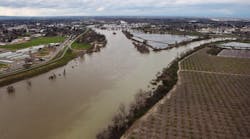DES MOINES, IA, Jan. 19, 2010 -- [FEMA] -- After watching the town he lives in get inundated with flood waters in the historic Iowa floods of 2008, Tom Watson of Palo, Iowa knows that you can't stop the water from flowing.
But with a little ingenuity, and some good old-fashioned common sense, Watson and Palo officials have come up with ways so waters from swollen streams can be diverted or siphoned off to lessen the impact of future flooding and protect the citizens and business owners of Palo.
"Palo, to put it simply, is located in the bottom of a basin," said Watson, who was named Palo's Infrastructure Commander following the 2008 floods. "We have a lot of water flowing through this area. That doesn't mean, however, that all the water has to flow through Palo. There are ways not only to redirect the flow of water, but to also increase the flow of water through an area so it doesn't back up flooding people's homes and businesses."
The town of Palo received assistance from the Federal Emergency Management Agency (FEMA) and Iowa Homeland Security and Emergency Management's Public Assistance 406 Mitigation program which not only restores a facility beyond its pre-disaster design, but also adds extra measures designed to minimize losses from the next emergency. In other words, a little extra money spent now may save untold funds later.
Under the current disaster, federal funds pay for 90 percent of the project and the state funds cover the remaining 10 percent. This includes 406 mitigation projects.
In fact, Iowa has consistently promoted 406 mitigation to the extent that the State utilizes this part of the program on about 25 percent of all permanent work projects.
For example, the town received $5,884 in 406 mitigation funds from FEMA to elevate panels and controls at a sanitary lift station.
"The sanitary lift station was on a cement pit before the floods of 2008 hit," said Watson. "After the 2008 floods, we totally redesigned the project so that the lift station now sits two feet higher than 2008 flood level, so immediately we became proactive to elevate everything we could. We feel we are extremely well protected."
Palo officials also changed the design criteria on the lift station. Before the floods of 2008, the town had two, 10 horse-powered pumps which pumped the sewage out of Palo. Now, the town has three 100 horse-power pumps.
That redesign has already paid off for the citizens of Palo. In September of 2009, the area received nine inches of rain in a 48-hour period, Watson said the pumps were able to keep the sewage out of people's basements.
"Those new pumps were pumping over 960,000 gallons of water out of the town in just one day alone during that period -- keeping the sewer lines dry," Watson said. "There would have been no way for the previous pumps to keep up. Overcapacity gave us an edge in keeping the sewage out of people's basements."
(See a video of this project online at: www.facebook.com/FEMA and www.youtube.com/fema).
In another mitigation project, Palo officials noticed that when they diverted water from entering one culvert to prevent a road from flooding, flood waters would back up into a farmer's field. As a solution, town officials put in a different culvert to divert the flood waters to an open area along beside a different road. This allowed the water to seep into the ground without flooding other areas and bypass the heart of Palo.
(Tom Watson explains this project on video, which can be seen online at: www.facebook.com/FEMA and www.youtube.com/fema).
Palo also received in FEMA 406 mitigation funds:
• To elevate the generator and transfer switch and to anchor the propane tank at the main pump station ($2,792)
• To provide flood resistant wall construction at the fire department pump house station ($1,755)
• To add flared end sections and revetment stone to a concrete culvert ($1,220)
In addition, Watson and Palo officials did small mitigation projects which already have made an impact. For instance, after consulting with Army Corps of Engineers officials, town officials cleared out downed limbs and cut down trees leaving the stumps out of waterways. This allowed for water to flow freely through the area instead of getting backed up and causing flooding.
Another small mitigation project was eliminating the curbs on some city streets to allow water to flow into back into ground instead of running back into the swollen streams. Since the flood of 2008, Palo officials have undertaken more than a dozen hazard mitigation projects.
"Those aren't a lot of high dollar projects," said Watson, "but all those little projects are just pieces of the puzzle to make things work. Little things like those projects have made a big difference."
About FEMA
FEMA's mission is to support our citizens and first responders to ensure that as a nation we work together to build, sustain, and improve our capability to prepare for, protect against, respond to, recover from, and mitigate all hazards.
###


